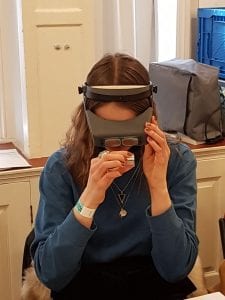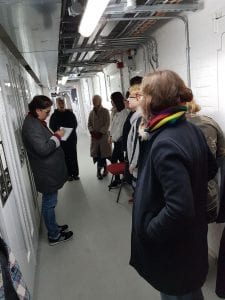Donna Gilbert, BA Fashion and Dress History, reflects a recent talk by fashion historian, Amber Butchart.
For Amber Butchart, a childhood spent trawling the charity shops and jumble sales of Lowestoft, Suffolk with her mother sparked a lifelong interest in vintage fashion and what many might envisage as a dream career path. Addressing students on the History of Art and Design programme in March 2019, Amber explained how these humble beginnings metamorphosed into a professional life encompassing television, radio, writing and, more recently, forensic science work.
The informal talk was both inspirational and realistic, with Amber highlighting how for every successful TV or publishing pitch, there were many rejections or ideas to be shelved for a later date. She began by explaining how her love for vintage fashion has informed both her personal and professional journey. Amber gained an MA in the History and Culture of Fashion at the London College of Fashion where she used a 1970s Biba dress originally owned by her mother to both inform and channel her studies. The dress inspired an interest in clothing and relationships and how the materiality of clothing can tell stories of past lives.
After completing a BA in Literature, Amber spent the summer of 2002 working for vintage store, Beyond Retro. She started on the shop floor but spent her lunch break researching vintage fashion and its social history. This interest not only led to a new role within the company as a buyer, focussing on quality control and coordination, but also established her as a valuable contact and source of knowledge for journalists who were becoming increasingly aware of the popularity of vintage fashion. This growing reputation as a vintage fashion expert also provided openings for television work. Amber first broadcast her research in a documentary for Radio 4, highlighting the global impact of discarded clothing from Europe and the US and its devastating impact on local garment industries in poorer countries.[1] She also described her role as presenter on the BBC4 series A Stitch in Time, screened in January 2018, which looked at historical figures through the clothes they wore, working with a team to recreate the clothing depicted in works of art.[2] More recently, in April 2018 she presented a fascinating documentary examining the Huguenot silk weavers of Spitalfields.[3]

Figure 2: Forensic archeologist Dr Karl Harrison and Amber Butchart examine forensic evidence. Photo: Pedro Alvarez, The Observer. www.theguardian.com
In the last part of her talk, Amber described how she was contacted by Dr Karl Harrison, a forensic archaeologist, after he heard her speaking about fashion history on the radio. Concerned that forensic science was relying heavily on DNA alone, he recognised the value of appointing a garment expert who could examine and potentially date clothing or textiles when they are found amongst a person’s remains. As Amber pointed out, material culture is very much about the stories which clothing can tell us, along with different applications of this understanding. Not surprisingly, she never thought that an interest in vintage fashion would result in her working with crime scene investigators or forensic analysts, but saw this as an exciting new opportunity. Interestingly, it loops right back to the beginning of her career at Beyond Retro, using the same sort of skills which she employed to train people in what to look for in garments and how to gauge the age of something in order to assess its value. The forensic science work encompasses both analysis and report writing and the training of crime scene investigators. Whilst the work is exciting and interesting, Amber explained that it comes with a unique set of issues; adapting to working with dead bodies and being around death is not something she ever thought she would be doing and requires careful contemplation.
Amber concluded her talk by pointing out the benefits of an enquiring approach, stating: ‘If you enjoy research, then learning new things is something you want to be doing all the time. For me to now have a whole new area that I can really get my teeth into and start learning and finding out about has just been really invigorating.’ Her closing comment served as a reminder to all History of Art and Design students of the benefits of a material culture approach, looking closely at objects and images, and how a love of research combined with an open mind and a willingness to explore new prospects can lead to exciting, yet unexpected, career opportunities.
[1] Rags to Riches. BBC Radio 4, Oct 2017. Web. https://www.bbc.co.uk/programmes/b08psd8t/broadcasts/2017/10
[2] A Stitch in Time BBC4, London, Jan 2018. Web. https://www.bbc.co.uk/programmes/b09l2qzs
[3] “The First Refugees,” Civilisations Stories. BBC1, April 2018. Web. https://www.bbc.co.uk/programmes/b0b1bhhd
















